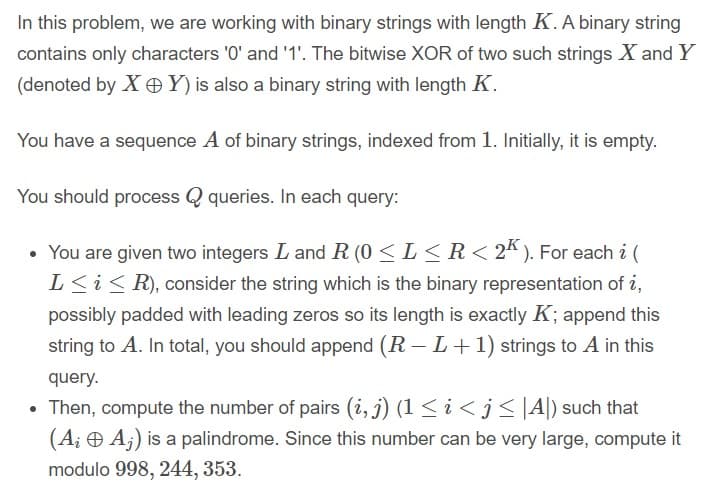In this problem, we are working with binary strings with length K. A binary string contains only characters '0' and '1'. The bitwise XOR of two such strings X and Y (denoted by X OY) is also a binary string with length K. You have a sequence A of binary strings, indexed from 1. Initially, it is empty. You should process Q queries. In each query: • You are given two integers L and R (0 < L < R < 2* ). For each i ( L
In this problem, we are working with binary strings with length K. A binary string contains only characters '0' and '1'. The bitwise XOR of two such strings X and Y (denoted by X OY) is also a binary string with length K. You have a sequence A of binary strings, indexed from 1. Initially, it is empty. You should process Q queries. In each query: • You are given two integers L and R (0 < L < R < 2* ). For each i ( L
Computer Networking: A Top-Down Approach (7th Edition)
7th Edition
ISBN:9780133594140
Author:James Kurose, Keith Ross
Publisher:James Kurose, Keith Ross
Chapter1: Computer Networks And The Internet
Section: Chapter Questions
Problem R1RQ: What is the difference between a host and an end system? List several different types of end...
Related questions
Question
C++
Example Input
1
2 3
3 6
2 3
Example Output
3
7

Transcribed Image Text:In this problem, we are working with binary strings with length K. A binary string
contains only characters '0' and '1'. The bitwise XOR of two such strings X and Y
(denoted by X OY) is also a binary string with length K.
You have a sequence A of binary strings, indexed from 1. Initially, it is empty.
You should process Q queries. In each query:
• You are given two integers L and R (0 < L < R< 2* ). For each i (
L<i< R), consider the string which is the binary representation of i,
possibly padded with leading zeros so its length is exactly K; append this
string to A. In total, you should append (R – L+1) strings to A in this
query.
• Then, compute the number of pairs (i, j) (1 < i < j <|A|) such that
(A¡ Ð A;) is a palindrome. Since this number can be very large, compute it
modulo 998, 244, 353.
Expert Solution
This question has been solved!
Explore an expertly crafted, step-by-step solution for a thorough understanding of key concepts.
Step by step
Solved in 2 steps with 1 images

Recommended textbooks for you

Computer Networking: A Top-Down Approach (7th Edi…
Computer Engineering
ISBN:
9780133594140
Author:
James Kurose, Keith Ross
Publisher:
PEARSON

Computer Organization and Design MIPS Edition, Fi…
Computer Engineering
ISBN:
9780124077263
Author:
David A. Patterson, John L. Hennessy
Publisher:
Elsevier Science

Network+ Guide to Networks (MindTap Course List)
Computer Engineering
ISBN:
9781337569330
Author:
Jill West, Tamara Dean, Jean Andrews
Publisher:
Cengage Learning

Computer Networking: A Top-Down Approach (7th Edi…
Computer Engineering
ISBN:
9780133594140
Author:
James Kurose, Keith Ross
Publisher:
PEARSON

Computer Organization and Design MIPS Edition, Fi…
Computer Engineering
ISBN:
9780124077263
Author:
David A. Patterson, John L. Hennessy
Publisher:
Elsevier Science

Network+ Guide to Networks (MindTap Course List)
Computer Engineering
ISBN:
9781337569330
Author:
Jill West, Tamara Dean, Jean Andrews
Publisher:
Cengage Learning

Concepts of Database Management
Computer Engineering
ISBN:
9781337093422
Author:
Joy L. Starks, Philip J. Pratt, Mary Z. Last
Publisher:
Cengage Learning

Prelude to Programming
Computer Engineering
ISBN:
9780133750423
Author:
VENIT, Stewart
Publisher:
Pearson Education

Sc Business Data Communications and Networking, T…
Computer Engineering
ISBN:
9781119368830
Author:
FITZGERALD
Publisher:
WILEY